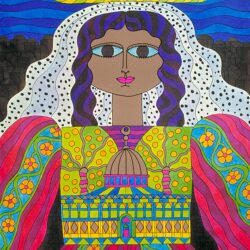The story of Textile as Resistance: Curators take the stage

Who are Samira Bendadi and Mashid Mohadjerin and where did they find their inspiration for the moving and captivating stories for the new exhibition ‘Textile as Resistance’?

Migration and identity are subjects that play important roles in the work of Mashid Mohadjerin and Samira Bendadi. Samira is a journalist at MO* Magazine. She is specialised in North Africa and the Middle East and writes about themes linked to migration, asylum and diversity. She started her career at Radio Vlaanderen Internationaal and has made documentaries and reports for VRT, Radio 1 and TV-Brussel. She has also written a book called ‘Dolle Amina’s. Feminism in de Arabische wereld’, about feminism in the Arab world, which was published in 2008. Mashid Mohadjerin is a photographer whose work has been published in The New York Times, The Wall Street Journal, The Guardian, De Standaard, and Le Monde. Mohadjerin’s work explores the boundaries between artistic and documentary photography. She studies identity and migration and has travelled the world in search of human-interest stories.
Textile as Resistance, teaser
Stories behind Textile
The combination of two strong women accumulates into a fascinating exhibition based on human stories. Samira talks about the process of building up the exhibition, filled with stories about resistance, fleeing, hope, tradition, beauty, spirituality and decolonization.
The past months Mashid and I have sat together quite regularly, to exchange thoughts and to discuss about our new project for the Fashion Museum in Antwerp. Which stories should we bring and where are we going to find them? From which perception are we going to look at textile? Are we going to talk about fashion? About clothing? About decoration? About tablecloths or carpets?
Eventually we concluded it doesn’t really matter what the piece of textile is meant for. The most important is what the fabric tells us.
Asylum, migration and resistance are the reoccurring themes in our research. And we started close to home, here in Antwerp. We walked past the stores in the city. It struck us that there are a lot of fabric and clothing stores for minority groups, but what does that tell us? How are these fabrics used? What message do the people, consciously or unconsciously, convey when wearing these clothes? The quest started in Antwerp but is far from complete. It did confront us with the mix of nationalities in Antwerp.
We started with what intrigued us the most and that was the presence of Syrian refugees in the city. To some extend we know how their living conditions are in Belgium, but what about the Syrian refugees in the neighbouring countries of Syria?
Through textile we wanted to get to know more about the effects of the Syrian war on its inhabitants. The choice of which country we would be visiting first was a no-brainer: Lebanon.
Remembering and healing wounds
Lebanon is a patchwork of communities, cultures and ethnical minorities. Since the start of the Syrian war, the country has taken care of no less than 1,5 million refugees. Life is already expensive for the Lebanese people and even more for the refugees. But this isn't something new:-asylum and exile, war and the consequences of it seem to be intertwined with Lebanon. The country that counted about 4,5 million inhabitants before the war.

Lebanon doesn’t have a reception policy for refugees, for example, they’re not allowed to work officially, only informal. They’re mainly active in the agriculture and in construction. For the majority of them it’s about surviving, everyone is vulnerable: man, woman and child. The newcomers carry a lot of baggage with them, not just clothes and things they brought from home, but also fear, sadness, the feeling of loss, … They may be economically weak but they still carry knowledge and skills with them.
The art is to bring out those skills, to develop them and to build up new abilities. We were able to meet up with many powerful women who work towards the empowerment of women through textile. And who want to protect their own heritage and the stories and memories for the future generations.
Zena Sabbagh, for example, who fled the Syrian war herself, opens her door and her heart for women who want to sew and embroider. In her apartment in the neighbourhood Badora, she introduces them to new techniques, but also gives them the freedom to create something themselves. In her studio there are no conditions of who is allowed in and when, the door is always open and everyone is welcome.
We also met with Samira Salah who works with women in refugee camps in Palestine. In one camp the women embroider, in the other they sew. It’s a method to help women earn an income and to preserve the Palestinian cultural heritage. Lastly, they also make sure that their heritage is not taken away from them.

Malak Bakoor has gathered a group of women around her in the refugee camp Shatila. Together they embroider and sew for Lebanese designers. They work with recycled materials and receive small orders from Canada.


Arpi Mangassarian sees herself as a true Lebanese. Though, her Armenian background still plays a strong role in her identity. She founded Badguèr Art & Craft Heritage Centre, a cultural centre, along with her parents and brother to preserve the memories of her people and to pass it on to future generations. Different aspects of the Armenian culture are on display, including textiles and embroidery from the own region that is part of her heritage.

For those who want to discover all the stories and images of the duo, can visit the expo at Texture Kortrijk from 15 November 2019 until 16 February 2020. After Kortrijk, the exhibition moves to Kunsthal Extra City in Antwerp and is on display from 21 March until 19 April 2020.








